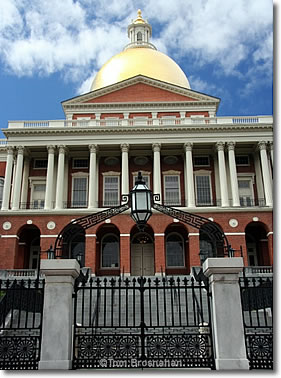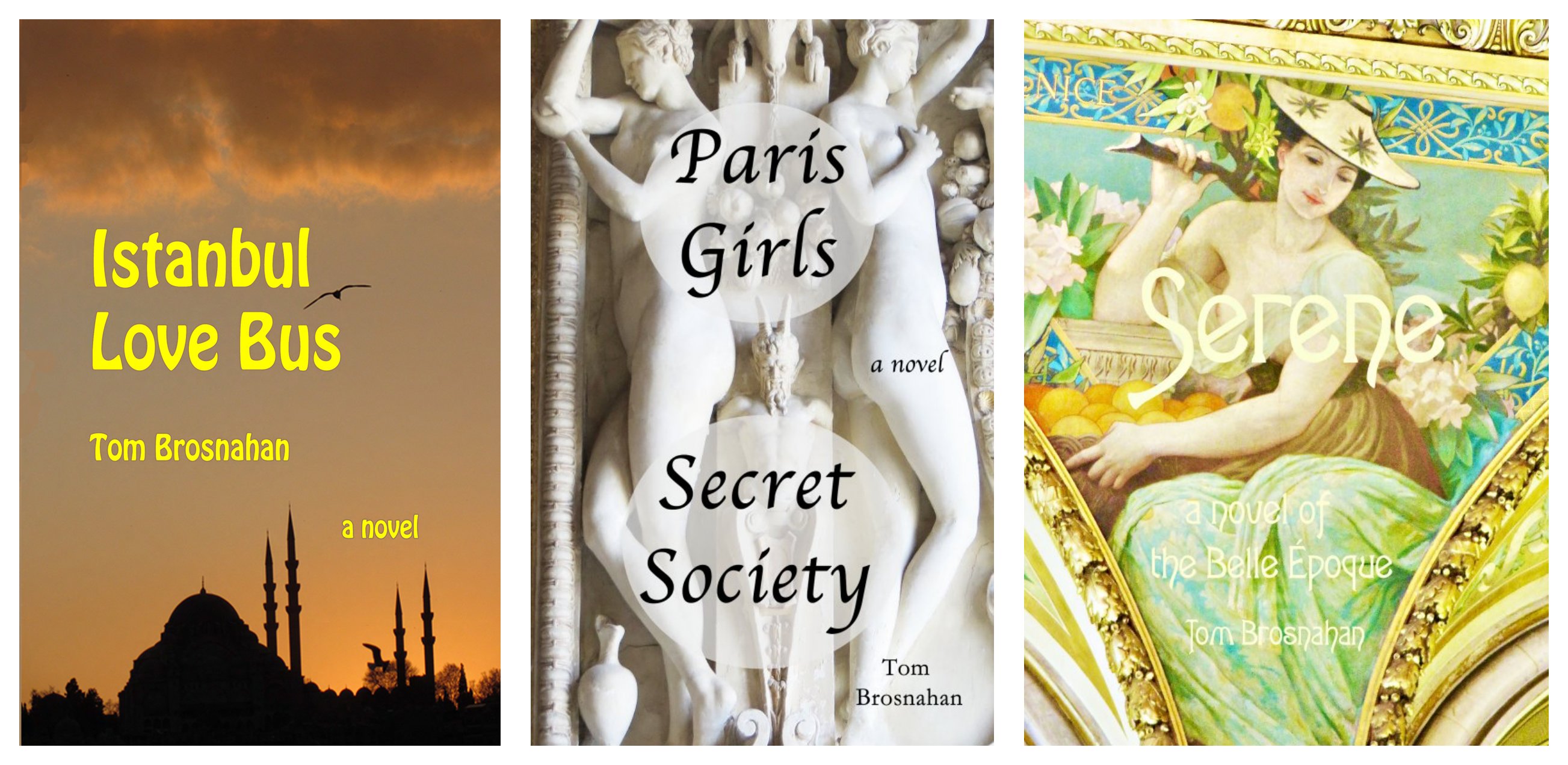Beacon Hill & Downtown Boston Walking Tour
This 2-hour, 1-mile (1.4-km) walk starts on Boston Common and ends at Faneuil Hall Marketplace. It's a shorter, modified version of the Freedom Trail walk.

The Massachusetts
State House.
Sunday morning is most peaceful, but any morning will do (however, the State House is closed on weekends).
Take the MBTA subway to Park Street station, where you emerge at the easternmost corner of:
1. Boston Common
Boston Common, the colonial town's "common pasture land," to which any citizen's cows could be brought. It's now Boston's central park. Stroll through the Common as you like, making your way up the slope to the
2. Massachusetts State House
Massachusetts State House, which dominates Beacon Hill and Boston Common, its gold dome shining and visible for miles. It was designed by Charles Bulfinch, Boston's most famous and best-loved architect, and built at the end of the 1700s. This is where the Massachusetts General Court (legislature) sits today.
From the rear (north) side of the State House, turn left and walk along
3. Mount Vernon Street
Mount Vernon Street, the prettiest street on Beacon Hill, Boston's prettiest residential neighborhood. The brick Federal-style houses are all superbly kept. In a few minutes you'll come to
4. Louisburg Square
Louisburg Square, laid out in the 1840s with its tiny private park, The square is Beacon Hill's architectural gem, and its most prestigious address. (John Kerry and Theresa Heinz Kerry have a house here.) The park is owned in common by the residents of the houses facing the square.
Continue down the hill on Mt. Vernon to West Cedar St. and turn left. The next street on the left is
5. Acorn Street
Acorn Street, a short street that is so picturesque it is almost synonymous with Beacon Hill. If you see a photograph of a Beacon Hill street, it's probably of Acorn Street!
Continue to the next corner and turn right onto Chestnut Street, like Mount Vernon Street, lined with fine Federal brick row-houses. At the top of Chestnut St. turn left, then right on Mount Vernon, then left on Joy St. Descend the hill on Joy to the corner with Myrtle, near which you'll see the
6. African Meeting House
African Meeting House, 8 Smith Court (tel. 723-8863), built in 1806 and now the nation's oldest African-American church building. Though it's now set up as a museum, it was once the venue for speeches by abolitionists William Lloyd Garrison and Frederick Douglass. Nearby, and equally interesting, is the
7. Museum of African American History
Museum of African American History, 46 Joy St. Reserve your entry time online.
Walk back up Joy St., around to the front of the State House and down Park St., back to the intersection of Park and Tremont streets. Directly across Park Street from the subway station entrance is the
8. Park Street Church
Park Street Church, the tall-steepled, graceful church designed by Peter Banner and built in 1809. William Lloyd Garrison thundered against slavery from the pulpit here in 1829, and thus began his long abolitionist campaign. Take a look inside, so you can compare this early 19th-century church with the earlier churches farther along the Freedom Trail. The church (tel 617-523-3383) is open to visitors from late June to late August, Tuesday through Saturday, 9:30 am to 3:30 pm; closed July 4th; Congregational services are held all year on Sunday at 10:30 am and 6 pm.
Come out of the church, turn left and walk along Tremont Street a few teps to the
9. Old Granary Burying Ground
Old Granary Burying Ground, last resting-place for some of the American Revolution's most famous figures, including Samuel Adams, Peter Faneuil, John Hancock and Paul Revere. Crispus Attucks and the other victims of the Boston Massacre (March 1770) were laid to rest here, as were Benjamin Franklin's parents.
Continue northeast on Tremont Street to the intersection with School Street and
10. King's Chapel & Burying Ground
King's Chapel, which dates from 1754. Once the Anglican church of the royal governors, then the Episcopalian church of Boston's great personages, this dark mass of granite is now a Unitarian meetinghouse. The bell was cast by Paul Revere, and is the largest he ever made.
The Burying Ground beside the chapel is the second-oldest in the city.
Walk down School Street to the
11. Statue of Benjamin Franklin
Statue of Benjamin Franklin. Most Americans remember the story of Franklin getting off the boat in Philadelphia with very little money and two loaves of bread for sustenance to begin his famous career, but some people forget that he was coming from Boston, his birthplace (1706) and childhood home; he was born in a house on nearby Milk Street (see below). This statue by Richard Greenough (1856), in front of Boston's old city hall, pays tribute to Boston's famous son, who is buried in Philadelphia.
Near the statue (follow the red line) is the
12. Site of the First Public School
Site of the First Public School to be established in the American colonies (1635), which boasted Cotton Mather, Benjamin Franklin and Samuel Adams among its alumni. Though the building is gone, the school survives as Boston Latin School, the city's most prestigious high school, located now in the western part of the city.
Continue down School Street to the corner of Washington Street and the
13. Old Corner Bookstore
Old Corner Bookstore. The building dates from 1718, but its fame began when it became a gathering place for famous American authors in the 19th century. At that time bookstores were also publishers, and Messrs. Ticknor & Fields, who ran the Old Corner Bookstore, published and drank coffee with the outstanding literary men of the age, including Ralph Waldo Emerson, Nathaniel Hawthorne, Oliver Wendell Holmes, Henry Wadsworth Longfellow, and John Greenleaf Whittier.
Turn right and walk a block to the
14. Old South Meeting House
Old South Meeting House, 310 Washington St., at the corner of Milk St. New England congregations call their buildings meetinghouses rather than churches, and it's from this that the Old South Meeting House gets its name, although it was used for town meetings as well. (Old North Church, from which the lanterns hung to signal Paul Revere, is a different building farther along the Freedom Trail.)
Built in 1729, the meetinghouse saw its most famous meeting on December 16, 1773, when a group of colonials in Indian dress set out from here to throw the Boston Tea Party.
Today the building is a museum with exhibits of historical documents, currency, furniture, and a scale model of Boston in 1775, which gives you a very clear idea of the size and layout of the town. An audio-visual show recounts Old South's history.
Around the corner on Milk Street is the
15. Benjamin Franklin's Birthplace
Site of Benjamin Franklin's Birthplace, marked by an obscure plaque on the side of a skyscraper. Though Franklin (1706-1790) made his fame and fortune in Philadelphia, he was a Boston native who learned his printing trade here in the shop of his half-brother James.
Backtrack on Washington St., past the Old Corner Bookstore, to find
16. The Old State House
The Old State House. The charming brick building at 206 Washington Street dates from 1713, and was built to house the colonial government; after the Revolution it was known as the State House, and after the present State House was built in 1795, this one became the Old State House.
The Declaration of Independence was first read to Bostonians from its balcony in 1776.
From that same balcony, George Washington addressed the citizens of Boston in 1789.
Now that the building is hemmed in by giant buildings on all sides, much of the dignity it must have held for colonial and revolutionary Americans is lost.
Inside, a museum has changing exhibits. Historical talks are given on the hour. There's an entry fee to the museum (tel 617-720-1713).
Walk east down Court St. and State St. two short blocks to the
17. Boston Massacre Site
Boston Massacre Site, near the corner of State St. and Congress St., where colonists protesting the excesses of the royal government confronted some British soldiers who then fired (March 5, 1770) into the crowd, killing five men. The incident served to enflame anti-British feeling in the colonies which led, five years later, to the outbreak of the revolutionary war.
Turn left and go down Congress St. a half block to
18. Faneuil Hall
Faneuil Hall, (pronounced FAN-yool or FAN'l), the "Cradle of Liberty," so called because of citizens' meetings which were held here before and during the Revolution. The handsome brick building was erected by the Town of Boston in 1742 with money given by Peter Faneuil; designed by John Simbert, it was later enlarged by Bulfinch (1805).
Facing Faneuil Hall is the stout grey granite facade of
19. Quincy Market
Quincy Market, named for Boston Mayor Josiah Quincy who had it erected in 1826, along with the large Greek Revival market buildings on either side. Quincy Market was Boston's larder for a century before the changing patterns of commerce and provisioning led to its decline. Its restoration in the 1970s, along with the North Market and South Market buildings, has created the booming Faneuil Hall Marketplace you see today.
Continue Your Walking Tour
This ends the Beacon Hill & Downtown Boston Walking Tour. You can continue your walk starting from Faneuil Hall Marketplace on my North End & Charlestown Walking Tour.
Return to Boston Common
To return to your starting-place on Boston Common, walk west uphill past Boston City Hall to Government Center and take an MBTA Green Line train inbound for one stop to Park Street Station; or walk ten minutes south along Tremont Street (map).
